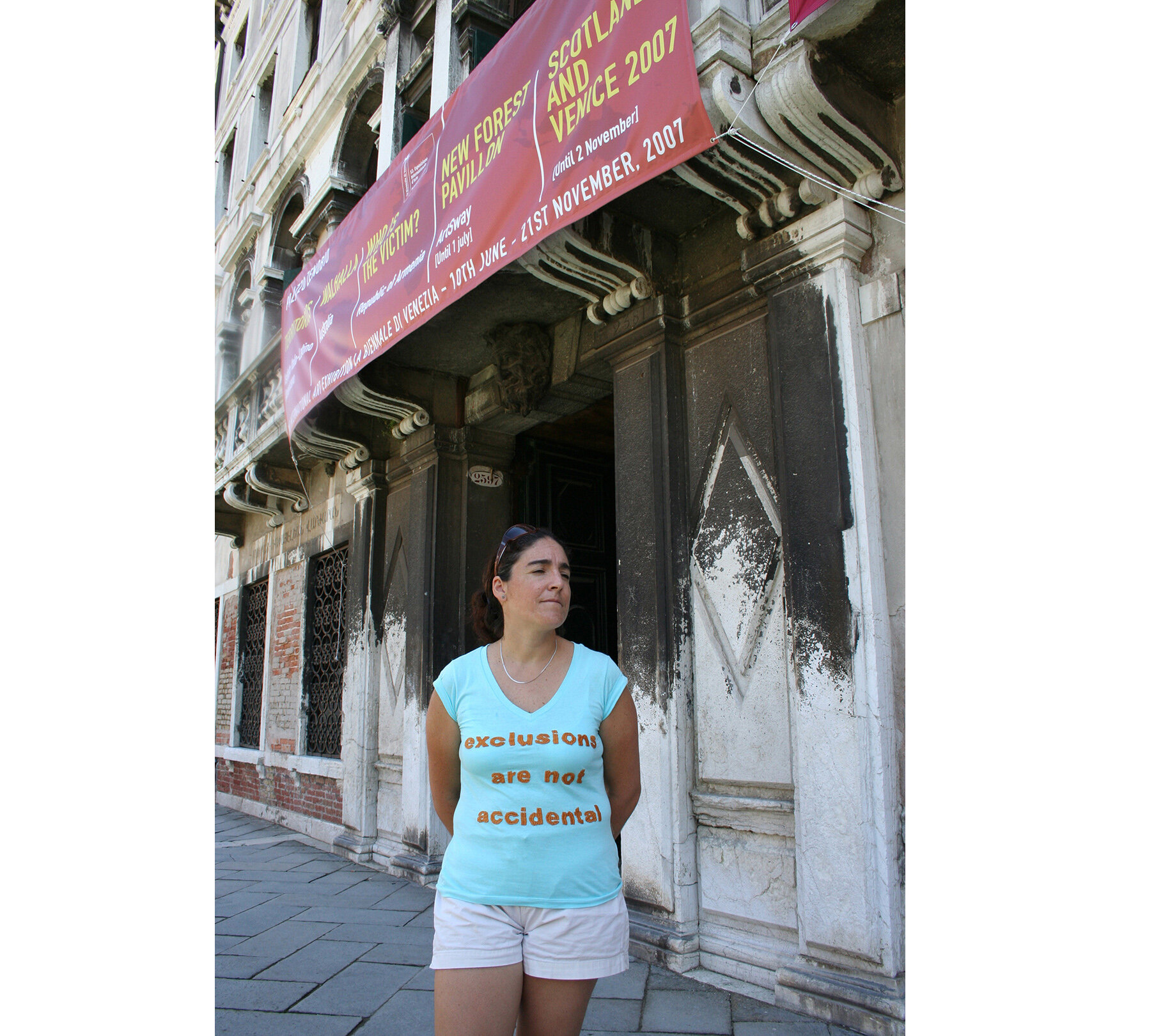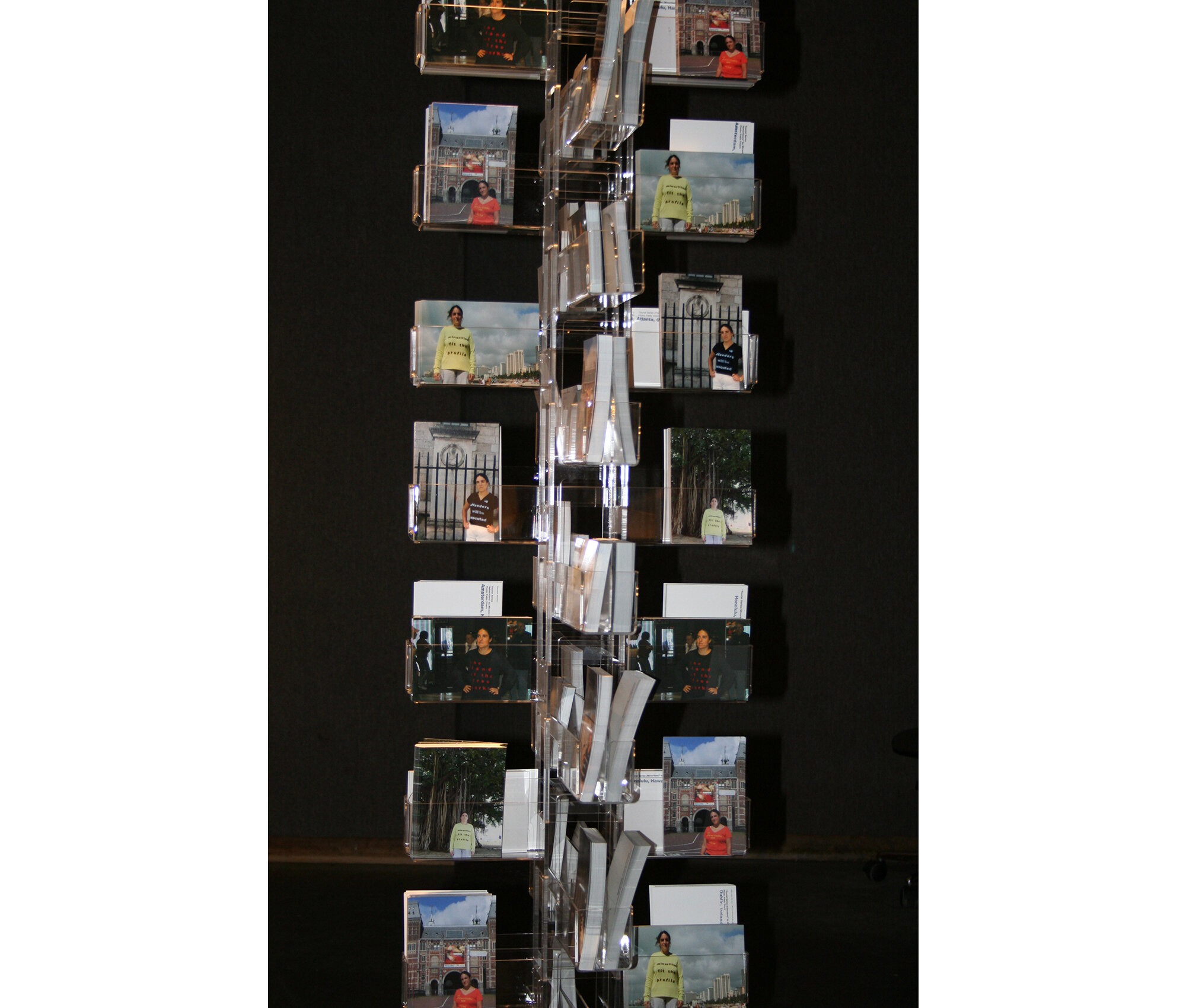
Tourist Series
Vivero, playing the role of a tourist, creates instant images, photographic souvenirs of her journeys that, although personal or autobiographical, capture the conventionality of such contemporary locations. She therefore employs a performative camouflage to reveal their reality, a world full of trivial images. That is what her embroidered T-shirts do: by wearing them while posing, almost intruding, in those places, she mocks and questions their touristy condition.
Throughout history there has been a deep and implicit connection between art and human identity. Vivero consciously explores it by questioning the impulse to privilege a dominant view of the world that differentiates between hegemony and periphery. She departs from the traditional European perspective, that is, the exoticism that pervaded the world view of 18th- and 19th-century travelers. Indeed, with her sight and her word, Vivero conquests the world, her world.
(Excerpt from writing by Mónica Vorbeck for LatinArt.com)

Tourist Series (friendly alien) - Kunsthaus Graz, Austria

Tourist Series (conquest) - Uhrturm am Schloßberg - Graz, Austria

Tourist Series (tourist) - Ukko Koli, Koli, Finland

Tourist Series (tourist) - midnight sun celebration, Koli, Finland

Tourist Series (developing artist) - Guggenheim Museum, New York, USA

Tourist Series (minorities) - Waikiki Beach, Honolulu, Hawaii

Tourist Series (exclusions) - Biennale di Venezia, Venice, Italy

Tourist Series (visa) - Helsinki Cathedral, Helsinki, Finland

Tourist Series (advertising) - Rijksmuseum, Amsterdam, The Netherlands

Tourist Series (offenders) - Robert Emmet Memorial, Merchants Quay, Dublin, Ireland

Tourist Series (postcards)
Tourist Series is a decolonial project that looks at hegemony critically. Having grown up in the global south, I express my point of view of the world through this project. I am a traveler, an inverse colonizer, but I’m playing the role of a tourist. As a “tourist” I find stores that are full of objects: postcards, T-shirts, caps, wristbands, cups, and piggy banks. These objects are targeted to the many visitors, who want to take with them a piece of the place they visited. Filling their bags with souvenirs, tourists find in them a justification of the long waiting hours, and the big sums of money they invested to acquire them. The accumulation of these objects follows the idea of the cabinets of curiosity, very popular in the 16th Century, where exotic artifacts from distant cultures are displayed. Today however, the objects sold in souvenir stores look alike everywhere. Only the name of the place printed on the objects is different. In a world that is interconnected and homogenized, are we travelers searching in vain for the uniqueness of the places we visit?
As a traveler, I have something to say about the places I visited, I have something to add to the picture presented to me. Centuries ago world explorers, as for example Alexander von Humboldt exploring the Americas, showed a world that was being discovered through their eyes, their experiences, their curiosity and their intrigues. Now, why shouldn’t we question the image that is put in front of us, if we can all be world explorers? How do we explore a hegemonic world today? To communicate these questions I chose two products: the T-shirt and the postcard. The T-shirt, which became very popular after WWII, is now a commonplace. T-shirts are used as part of clothing, but also as a support for self-expression and advertising. In souvenir stores they become an expression of the place they are intended to represent. Moreover, the T-shirt is a product of cheap labor; it is a silent accomplice of low wages. Postcards, on the other hand, are around since the end of the 19th Century and many times show images of places. They are intended to be send by mail at a lower cost than a letter. They have been used to send short messages and greetings, but also have been used as collectors’ items.
I have based this project in the practice of Performance Art and the tradition of the Self-Portrait. By traveling to different places this work has developed into “urban practices[i]”. Inspired by the places I visit, they express my resistance towards my condition as part of a minority. These comments are sometimes based on quotes, where I have changed one or more words, and their context, using irony, ambiguity and multiple readings. Whenever I travel, I try to find what it means to be in the place where I am and to produce artwork that expresses that meaning. More than just traveling, what I intend is to react and respond to my changing environment. Many times I am attracted to the “joys of identity-loss, and the pleasure of role-playing[ii]” in these new locations. As a sculptor who works with her hands, I embroider my responses on the T-shirt[iii] – hand embroidery is another expression of cheap labor and exploitation.
[i] Michel de Certeau, The Practice of Everyday Life
[ii] Marc Augé, Non-places
[iii] Embroidery is an ancient art form which probably originated in East Asia thousands of years ago. It was later spread out through Europe and through colonialism it came from Spain to the Americas, where it has been adopted by various groups as part of their traditional clothing.